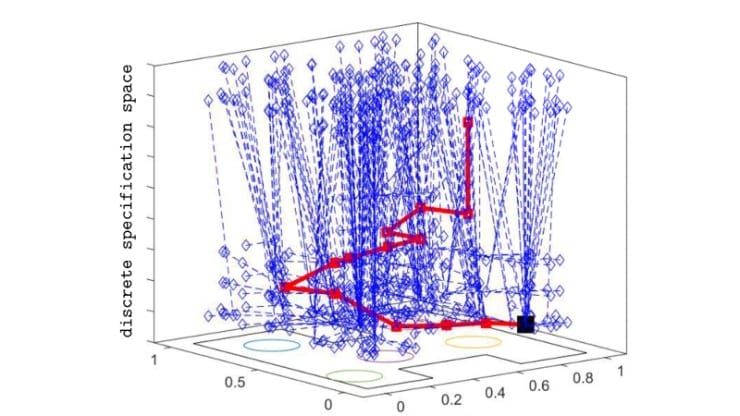
As a control algorithm moves robots through a space, each state the robots can be in is represented by a spot on the 3D graph. As the algorithm explores new options, it finds failures and potential next moves. This graph represents all of the wrong moves explored (blue) and the one route that is correct (red).
A new approach to designing motion plans for multiple robots grows “trees” in the search space to solve complex problems in a fraction of the time
In a building several stories tall with numerous rooms, hundreds of obstacles and thousands of places to inspect, the several dozen robots move as one cohesive unit. They spread out in a search pattern to thoroughly check the entire building while simultaneously splitting tasks so as to not waste time doubling back on their own paths or re-checking places other robots have already visited.
Such cohesion would be difficult for human controllers to achieve, let alone for an artificial controller to compute in real-time.
“If a control problem has three or four robots that live in a world with only a handful of rooms, and if the collaborative task is specified by simple logic rules, there are state-of-the-art tools that can compute an optimal solution that satisfies the task in a reasonable amount of time,” said Michael M. Zavlanos, the Mary Milus Yoh and Harold L. Yoh, Jr. Associate Professor of Mechanical Engineering and Materials Science at Duke University.
“And if you don’t care about the best solution possible, you can solve for a few more rooms and more complex tasks in a matter of minutes, but still only a dozen robots tops,” Zavlanos said. “Any more than that, and current algorithms are unable to overcome the sheer volume of possibilities in finding a solution.”
The researchers show that this method will always find an answer if there is one, and it will always eventually find the best one possible. They also show that this method can arrive at that answer exponentially fast. Working with a problem of 10 robots searching through a 50-by-50 grid space— 250 houses to pick up mail — current state-of-the-art algorithms take 30 minutes to find an optimal solution.
STyLuS* does it in about 20 seconds.
via Duke University
The Latest Updates from Bing News & Google News
Go deeper with Bing News on:
Robot swarms
- Robot-Explorers, Futuristic SpaceX Starships Set To Transform The Moon
Opinions expressed by Forbes Contributors are their own. Writing at the intersection of space and defense, focus on SpaceX, Mars' 1st cosmopolis. Squads of American explorers are counting down to ...
- Helldivers 2
To be clear, the latest major order charges players with liberating both Choohee and Penta, but according to Helldivers 2 ’s narrative, only the stratagem of the first one to be liberated will be ...
- Robots cannot outrun animals, but they’re evolving faster
Despite these efforts, today's robots still cannot match the natural abilities of many animals in terms of endurance ...
- Europe taps deep learning to make industrial robots safer colleagues
European researchers have launched the RoboSAPIENS project to make adaptive industrial robots more efficient and safer to work with humans.
- Swarm of nanorobots can remove tiny plastic fragments from water
Tiny magnetic robots can help remove some of the smallest plastic particles from polluted water.
Go deeper with Google Headlines on:
Robot swarms
[google_news title=”” keyword=”robot swarms” num_posts=”5″ blurb_length=”0″ show_thumb=”left”]
Go deeper with Bing News on:
Coordinating movements of multiple robots
- Movement Labs Raises USD 38 Million in Series A to Bring Facebook's Move to Ethereum
The investment round saw participation from prominent venture capital firms including Hack VC, Placeholder, Archetype, Maven 11, Robot Ventures, Figment Capital, Nomad Capital, Bankless Ventures, OKX ...
- Chip Industry Week In Review
U.S. workforce hubs; Samsung's V-NAND chip; TSMC's A16 process and SoW; NVIDIA's AI acquisitions; IBM to acquire HashiCorp; China/Japan AI EV partnerships; MIT's secure digital IMC chip; a foundry ...
- Movement Labs Raises $38M for Rollup Based on Facebook's Move Language
Movement's 21 and 24-year-old co-founders say they are on a mission to "make blockchain security sexy" with the launch of their L2.
- Anopheles stephensi Mosquitoes: An Old Problem, A New Threat to Malaria Mitigation
The ongoing global effort to combat malaria has a new challenge: Anopheles stephensi, a species of mosquito that is able to reproduce in enclosed, urban areas. The scientific community is adapting, ...
- New Jersey’s 3 Cheapest Grocery Stores, You Might Be Surprised
There are so many different grocery stores to choose from in New Jersey. But, I know you have your one favorite you probably always go to.
Go deeper with Google Headlines on:
Coordinating movements of multiple robots
[google_news title=”” keyword=”coordinating movements multiple robots” num_posts=”5″ blurb_length=”0″ show_thumb=”left”]










